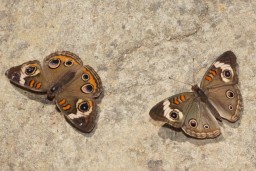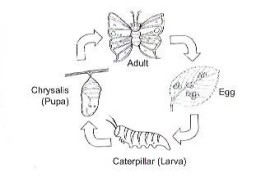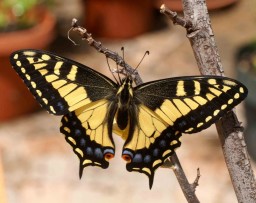 First the Birds, then the Bees and now … the Butterflies
First the Birds, then the Bees and now … the Butterflies
Decades ago I married into a family that loved insects, and most especially butterflies. As a result of this Lepidopteran love affair, we started raising butterflies as soon as our offspring could appreciate them. In fact, I seem to remember we were always writing excuse notes for our children’s lateness. The reason … the butterflies … perverse as they are, often chose to emerge just as the kids were getting ready for school. We still raise butterflies, and they continue to be a big part of our lives, to this day.

Happily, Santa Barbara is home to many kinds of butterflies, with more than twenty different species being recorded on More Mesa alone. Indeed, while researching our last Treasure Hunt, I came across a “West Coast Lady” on a Deerweed plant, and while researching this piece, I came across two “Buckeyes”. The butterfly season has arrived!
Butterfly Life Cycle is Very Short, but Complex …
The life cycle of most butterflies is two months or less, and has four distinct stages; Egg, Caterpillar, Pupa and Adult. Most of us see only the adult stage.
 Eggs begin a new cycle and are laid on plants that the caterpillar likes to eat … and the caterpillar is usually a very picky eater!
Eggs begin a new cycle and are laid on plants that the caterpillar likes to eat … and the caterpillar is usually a very picky eater!- The caterpillar’s job is to eat and grow. A tiny caterpillar emerges from the egg. Over several weeks, it will shed its skin 4 times to accommodate the growth needed to eventually become an adult. Indeed, when the caterpillar is ready to pupate, it weighs 3000 times what it weighed when it hatched from the egg. Its final task is to find a convenient and safe place to do its work as a pupa. At that spot, it will literally generate a hook to “hang” itself and turn into a pupal shape.
- The pupa is the transformative stage. This is the time a caterpillar becomes a butterfly. It is at the very end of the pupal stage that a butterfly emerges.
- The only job of the adult butterfly is to begin the cycle again. That is, it must find a mate, mate, and lay eggs. However, immediately after emergence, the butterfly must do some ‘prep’ work. First it pumps fluid into its wings and then dries them. Now it can fly. But it must also construct its proboscis, a long straw-like body part that will enable the butterfly to feed itself during the adult phase. During these 2-3 weeks, the butterfly only consumes enough food to stay alive until it lays eggs. Its food is the nectar of flowers and thus the process is called “nectaring”. (Notice that the food the adult uses to stay alive is different from the food the caterpillar needs to grow … and grow … and grow.)
* Thanks to the Museum of Natural History Butterfly Docent Program for the Life Cycle Graphic above.
Some Well Known Species Live Out the Whole Cycle on More Mesa…
There are at least two butterfly species that go through their entire life cycles on More Mesa; the Anise Swallowtail and the Common Buckeye. For the Swallowtail, that cycle can be anywhere from 6 to 10 weeks.

To start, eggs of the Swallowtail are deposited on the ubiquitous Fennel all over More Mesa. But while Swallowtails have been native to this area, Fennel is an introduced European plant. I wondered how that could work. Here’s how … Fennel is a member of the carrot family; a large family with many domesticated members, and many wild members as well. For example, the Swallowtail caterpillars may have used native Hemlock as caterpillar food before Fennel came on the scene.
The Common Buckeye life cycle is similar to the Swallowtail. However, Buckeye caterpillars are not as picky as most caterpillars. They eat several species of Plantain, a family of low growing flowering plants … also readily available on More Mesa. On the other side of our country, Buckeyes from Florida prefer False Foxglove, as well as other eastern plant types. Buckeyes tend to be found closer to the ground, whereas Anise Swallowtails fly much higher. Look for them throughout the Spring, Summer and Fall.
They Are Beautiful, But What Are They Good for?
There should be no argument that butterflies are beautiful and watching them makes us all feel really good. They are a truly charismatic family. But they are also a functioning part of their ecosystem. Although they are often referred to as pollinators, that service is more of an accident, and not extremely effective. While a butterfly can inadvertently fly away with some pollen on its legs after it has been nectaring, that surface area is extremely small compared to what a bee can carry off.
Caterpillars are food for other animals. For example, a tiny bird like the
Eurasian Blue Tit, which weighs less than ½ an ounce, will need to find
nearly 20,000 caterpillars to raise one average clutch of youngsters.

Most importantly, because butterflies are indicators of a healthy environment and healthy ecosystems, they become effective indicators of environmental disturbances and can be used to find answers to complex scientific questions.
All of the above aside, and in the final analysis, most of us would agree with Alan Watts when he said …
BUTTERFLIES ARE NATURE’S WAY OF WRITING POETRY.
Remember: Six Feet Apart and Stay Safe,
Valerie …
This Treasure Hunt is a family affair … all photos by Donley Olson